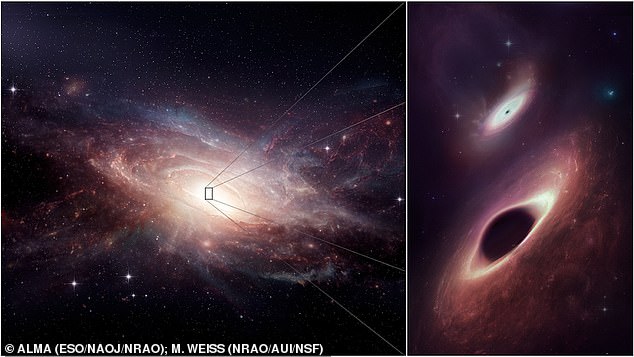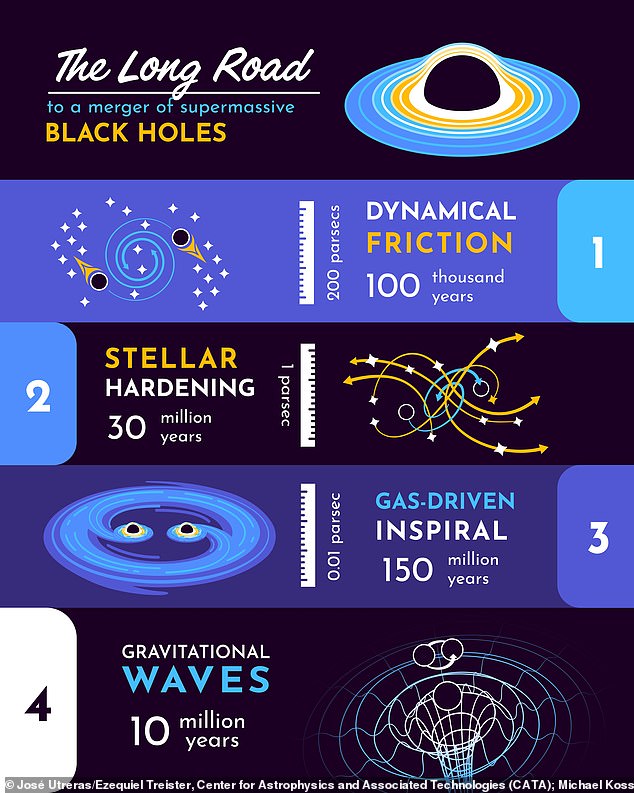Two supermassive black holes found dining side-by-side with just 750 light-years between them
>
Black hole BANQUET! Scientists discover two supermassive black holes dining side-by-side with just 750 light-years between them
- Two supermassive black holes have been spotted ‘dining’ side-by-side
- The pair are growing simultaneously just 750 light years apart
- Astronomers believe they will eventually combine into a gargantuan black hole
<!–
<!–
<!–<!–
<!–
<!–
<!–
One black hole is mind-boggling enough – a region in space where gravity is so immense that nothing, even light, can escape from it.
Now astronomers have discovered something even more remarkable, as two black holes have been spotted ‘dining’ side-by-side.
The pair are growing simultaneously just 750 light years apart – the closest scientists have ever observed – and will eventually combine into a gargantuan black hole.
They were discovered by researchers using the ALMA telescope, the most powerful telescope for observing molecular gas and dust, which is located in the Atacama desert.

One black hole is mind-boggling enough – a region in space where gravity is so immense that nothing, even light, can escape from it. Now astronomers have discovered something even more remarkable, as two black holes have been spotted ‘dining’ side-by-side
As the team were looking at two galaxies merging in the constellation Cancer, 500 million light years from Earth, they saw something they ‘didn’t expect’.
They spotted two glowing black holes, gluttonously devouring the dust, gas and other material being displaced by the merger, as if at a banquet.
While the black holes are close together in cosmological terms, they won’t merge for a few hundred million years.
Eventually, they will begin circling each other, with the orbit tightening as gas and stars pass between them.


The pair are growing simultaneously just 750 light years apart – the closest scientists have ever observed – and will eventually combine into a gargantuan black hole
Ultimately the black holes will start producing gravitational waves far stronger than any that have previously been detected, the researchers said, before crashing into each other to form one jumbo-sized black hole.
The findings also suggest that binary black holes and the merging galaxies that create them may actually be surprisingly common in the Universe.
Experts said the use of ALMA, which stands for Atacama Large Millimetre/submillimetre Array, was a ‘game changer’ and that finding two black holes so close together could pave the way for additional studies of the phenomenon.
Michael Koss, lead author of the research, is from the National Radio Astronomy Observatory.
He said: ‘ALMA is unique in that it can see through large columns of gas and dust and achieve very high spatial resolution to see things very close together.
‘Our study has identified one of the closest pairs of black holes in a galaxy merger, and because we know that galaxy mergers are much more common in the distant Universe, these black hole binaries too may be much more common than previously thought.’
The results of the new research were published in The Astrophysical Journal Letters and presented at the meeting of the American Astronomical Society in Seattle, Washington.
If you enjoyed this article:
Earth hit by strange ‘gamma-ray burst’ blast of high-energy radiation from the collision of two neutron stars
Scientists unlock secrets of ‘burping’ supermassive black holes
‘Black hole police’ discover the first dormant black hole outside the Milky Way
